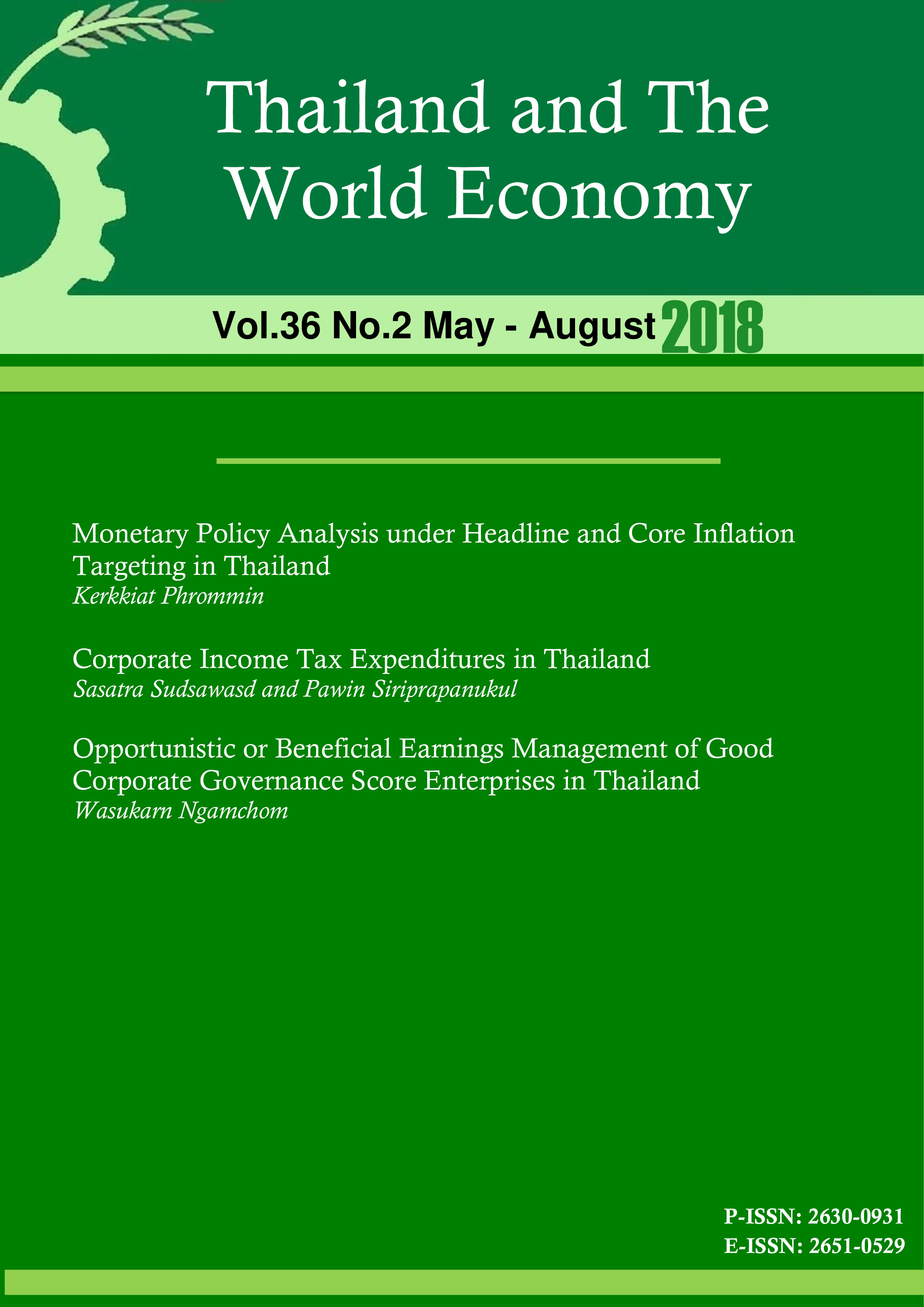Monetary Policy Analysis under Headline and Core Inflation Targeting in Thailand
Keywords:
Monetary Policy, Inflation targeting, ThailandAbstract
This paper analyzes monetary policy in Thailand under core and headline inflation targeting regimes by using a small open economy DSGE model. The model, modified from Adolfson (2007), is based on the New Keynesian framework. We assume incomplete exchange rate pass-through. The results are estimated using Bayesian inference for 2001Q1 to 2015Q4. Our key finding is that the headline inflation targeting regime performs better than the core inflation targeting regime in terms of lower welfare losses. Intuitively, under the headline inflation targeting regime, the exchange rate channel will be more effective, which leads to a decrease in the degree of policy trade-off. In addition, we find no concrete conclusion regarding whether the Bank of Thailand can improve welfare by adjusting the policy rate in response to real exchange rate movements.
References
Adolfson, M. (2001). Optimal monetary policy delegation under incomplete exchange rate pass- though. SSE/EFI Working Paper Series in Economics and Finance No.477, Stockholm School of Economics.
Adolfson, M., Laséen, S., Lindé, J., & Villani, M., (2007). Bayesian estimation of an open cconomy DSGE model with incomplete pass-through. Manuscript, Sveriges Riksbank.
Adolfson, M., Laséen, S., Lindé, J., Villani, M., & Sevenson, L. (2008). Monetary policy trade-offs in an estimated open-economy DSGE model. NBER Working Paper No. 14510, National Bureau of Economic Research.
Anand, R., & Prasad, E. (2010). Optimal price indices for targeting inflation under incomplete markets. NBER Working Paper No.16290, National Bureau of Economic Research.
Aoki, K. (2001). Optimal monetary policy responses to relative-price changes. Journal of Monetary Economics, 48(1), 55–80.
Bodenstein, M., Erceg, C., & Guerrieri, L. (2008). Optimal monetary policy with distinct core and headline inflation rates. Journal of Monetary Economics, 55(1), 18-33.
Corsetti, G., & Pesenti, P. (2000). International dimensions of optimal monetary policy. Mimeo University of Rome III and Federal Reserve Bank of New York.
Chai-anant, C., Pongsaparn, R., & Tansuwanarat, K. (2008). Role of exchange rate in monetary policy under Inflation targeting: A case Study for Thailand. Bank of Thailand Discussion Paper 2008-03, Bank of Thailand.
Dhawan, R., & Jeske, K. (2007). Taylor rules with headline inflation: A bad idea. Working Paper No.14, Federal Reserve Bank of Atlanta.
5). Monetary policy and exchange rate volatility in a small open economy. The Review of Economic Studies, 72(3), 707-734.
Khemangkorn, V., Sitthichaiviset, C. & Saikaew A. (2012). Inflation and monetary policy. Bank of Thailand Discussion Paper 2012, Bank of Thailand.
Jitpokkasame, P. (2007). Exchange rate pass through consumer price in Thailand. Master of Economics Thesis, Faculty of Economics, Thammasat University.
Mankiw, N., & Reis, R. (2003). What measure of inflation should a central bank target? Journal of the European Economic Association, 1(5), 1058-1086.
McCauley, R. N. (2006). Core versus headline inflation targeting in Thailand. Paper prepared for Bank of Thailand International Symposium, Bank of International Settlements.
McCallum, B., & Nelson, E. (2000). Monetary policy for an open economy: An alternative framework with optimizing agents and sticky prices. Oxford Review of Economic Policy, 16(4), 74-91.
Mishkin, F. S. (2007). Headline versus core inflation in the conduct of monetary policy. Presentation given at the Business Cycles, International Transmission and Macroeconomic Policies Conference, HEC Montreal.
Monacelli, T. (2005). Monetary policy in a low pass-through environment. Journal of Money, Credit and Banking, 37(6), 1047-1066.
Pongsaparn, R. (2008). A small semi-structural model for Thailand: Construction and applications. Modelling and Forecasting Team Monetary Policy Group, Bank of Thailand.
Pornpattanapaisankul, K. (2010). Monetary policy rule under an inflation targeting framework: Evidence from Thailand. Thammasat Economic Journal, 28(3), 143-179.
Smets, F., & Wouters, R. (2002). Openness, imperfect pass-through and monetary policy. Journal of Monetary Economics, 43(5), 554-578.
Smets, F., & Wouters, R. (2005). Comparing shocks and frictions in us and euro area business cycles: A Bayesian dsge approach. Journal of Applied Econometrics, 20(2), 161-183.
Tanboon, S. (2007). Stylized facts of the Thai economy. Unpublished manuscript, Bank of Thailand.
Wattanakorn, P. (2013). Exchange rate pass-through and inflation in Thailand. Thammasat Economic Journal, 31(2), 64-80.







